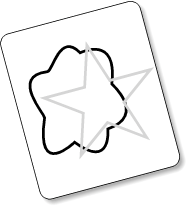Hack42.The Brain Punishes Features that Cry Wolf
|
Hack 42. The Brain Punishes Features that Cry Wolf
The act of focusing on just one object goes hand in hand with actively suppressing everything you have to ignore. This suppression persists across time, in a phenomenon called negative priming. In the story "The Boy Who Cried Wolf," the young shepherd repeatedly claims a wolf has come to attack his flock. There's no wolf there. The boy just enjoys seeing all the villagers run up the hill, coming to save him and the sheep. The villagers, naturally, get a bit annoyed at getting panicked and trying to scare off the nonexistent wolf, so when they hear the boy cry, "Wolf!" again in the middle of the night, they don't bother getting up. But this time there is a wolf. Oh dear. I could say the boy learns his lesson, but he doesn't: he gets eaten. Morality tale, very sad, etc. Negative priming is the tiniest psychological root of "The Boy Who Cried Wolf." A stimulus, such as a color, a word, a picture, or a sound acts like the cry of "Wolf!" The brain acts as the villagers did, and it has an inhibition to responding to meaningless cries, and this kicks in after only one cry. But nobody gets eaten. 3.10.1. In ActionNegative priming can be picked up only in experiments with careful timing and many trialsit's a small-scale effect, but it's been demonstrated in many situations. Look at the flash card in Figure 3-9, and say what the gray picture is as fast as you can. Speak it out loud. Figure 3-9. An example negative priming flash card Now look at Figure 3-10, and do the same: name the gray picture, out loud, as quickly as possible. Figure 3-10. The next flash card in the sequence You may find the picture in the second flash card slightly harder to make out, although really you need a controlled situation to pick up the reaction time difference. Both cards have a gray drawing to pick out and a black drawing to ignore, and you suppress both the black ink and the black image in order to ignore it. If, as is the case here, the image you have to identify in the second flash card is the same as the one you had to ignore in the first, you'll take a little longer about it. Your brain is acting like the second time the villagers hear the boy shouting "Wolf!"they still get out of bed, but it takes slightly longer to pull their clothes on. 3.10.2. How It WorksNegative priming has been found in situations much wider than when two colored pictures overlap. In that case, it's one of the pictures that has been negatively primed. But if you set up the experiment so one feature is selected at the expense of another, you can get negative priming for color, location, or shape. All it requires is for a feature to have been in your visual field but actively ignored, then subsequently that feature will take slightly longer to attend to. What's curious is, in the flash cards used earlier, you're concentrating on the ink color (gray or black), thus ignoring the black ink...but the negative priming occurs for the picture itself too. You've not even had to consciously ignore the distracter picture, because you can just look past the black ink, but it gets suppressed anyway. In a more extreme way, this is what is happening in inattention blindness [Hack #40] . You're concentrating on a certain set of features (white T-shirts, fast-moving), so you implicitly ignore anything that's colored black and is slow-movingand that's why an ape walking across the basketball game gets blanked. You're ignoring the features, not the objects themselves. Looking at the ape in the basketball game [Hack #41] is a good way to figure out what negative priming is happening for. Attention's resources are scarce, and we simply don't have enough to allow them to be consumed by every event that comes along. We need to be able to avoid being distracted by the ape if we're concentrating on basketball. It's the ability to suppress perceptions that makes actions truly voluntary.1 What's happening is that attention is being allocated to one set of features, then selectively disabled for potential disrupters. This inhibition function is pretty indiscriminate too, so any feature that's being discarded gets added to the ignore pile, whether it's relevant to the task at hand or not. It looks like a piano? Ignore. It's in black ink? Ignore. Contextual information, whether you focus on it or not, is inhibited, and you'll take longer to notice it when you next have to. Features stay on the ignore pile for much longer than they have to. Traces can be found not just seconds, but days and even weeks later.2 (Incidentally, this also provides evidence that weat least initiallyperceive objects as bundles of features that can be separately perceived and inhibited.) In a sense, negative priming is performing a similar selection function to focusing attention. It narrows down the quantity of perceptions that reach conscious awareness and can be responded to. In everyday life, you can see echoes of information filtering in action: you soon learn what noises foreshadow your car breaking down and which aren't relevant. And then, of course, there's the boy and the villagers. But these are long timescale, large effects. What's surprising is negative priming uses the same strategy, acting very quickly and almost entirely automatically. The narrowing down of information starts here, at the moment-to-moment and completely preconscious level. 3.10.3. End Notes
3.10.4. See Also
|
|
EAN: N/A
Pages: 159